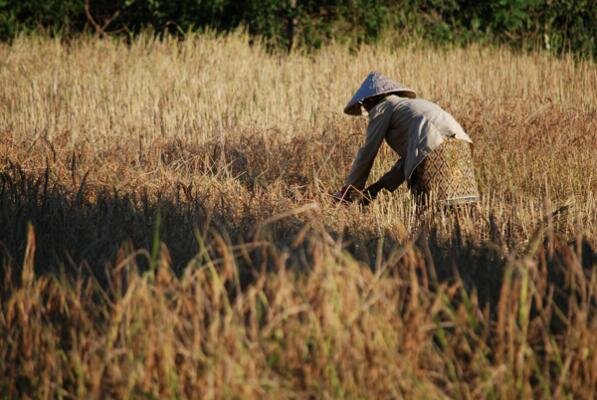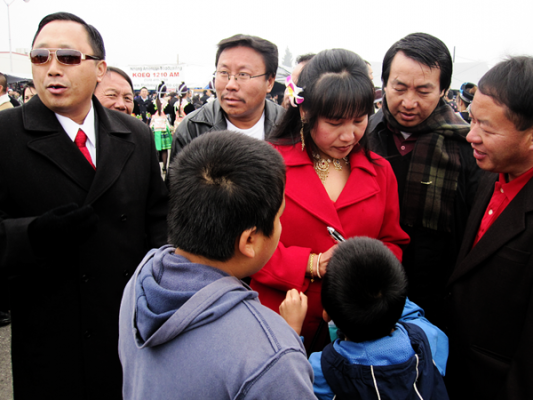It’s Hmong Mating Season!
It’s that time of the year again! Get into the game of Hmong ball tossing and find a mate on the spot.
The Hmong are found all over the world – from the US to Canada, Southeast Asia to China, Australia, France and Argentina. Back in the old country, Hmong Mating Season starts after the harvest. This is a time of rest after a whole year of working hard in the rice fields. Hmong people are so busy during the year that they don’t have time to find a mate until after the harvest.

Hmong Mating Season in California starts in October and ends on the first of January. This is a time when all the single Hmong males and females flock to the mating grounds to seek their potential mate. Single young girls and guys. Runaway brides and grooms. Divorcees. Widows and widowers. Even married people (mainly males) who thrive on the excitement of extramarital affairs!
These single Hmong males and females come in a display of colorful costumes. It really is a remarkable sight! They dress in their best to impress potential mates. Females dress in an array of bright pinks, greens, reds, oranges, whites, and blacks. Some even wear ornaments on their heads to match their bright colorful clothing. Males dress in clothes less vibrant than the females, but they’re still as appealing.
The females perform a ritual to show the males that they are open for mating. This ritual is called ball tossing. Two or three females gather, stand about four to five feet away from each other and toss a ball back and forth. Back in the old country, they use a ball made of cloth. Here in the US, the ball tossing ritual is performed with a tennis ball.
To show his interest in a female, a male Hmong will walk up to the female and ask her permission to toss ball with her. If she likes the male, she’ll accept his request. Most of the time, because the female Hmong feels she has no choice in the matter, she’ll passively say yes when she really wants to say no. If she has friends, the male will toss ball with her friends, too.
This ball tossing ritual dates back to the early Hmong times. The ball represents the relationship of a couple. Questions are tossed around so they can get to know each other more. The farther they are from the each other, the less they talk because they would need to yell at each other. Some people like to do the ritual just two feet from the other person, so they can actually get to know them better.
While the male is busy with the female Hmong, there may be other interested males standing by. Instead of joining in on the ball tossing ritual, they will simply surround her and carry out what is called the “Ear Whisper”. In the Ear Whisper, they whisper sweet-nothings, such as “Koj niam thiab koj txiv noj dab tsi cas yug tau koj zoo nkauj ntxim hlub ntxim nyiam ua luaj li os me nkauj Hmoob es (What did your parents eat to produce a girl so adorable and beautiful as you, Miss Hmong)?” She’ll giggle because it’s the biggest form of compliment anyone has given her. And then she eventually loses her concentration from the ball tossing game.

If wearing colorful clothing and tossing ball does not attract potential mates, the females use their mating call. This mating call is called Kwv Txhiaj. Kwv Txhiaj is a genre of traditional Hmong folk songs. The kwv txhiaj sang at the grounds are songs of mating, courtship, and relationships. For the Hmong who come to the mating grounds with their mate, instead of tossing balls the traditional way, they may participate in a ball tossing game similar to Strip Poker. [Oh yes!] The male and female stand five to six feet (or farther) from each other and toss the ball as fast and hard as they can. If the person on the other end cannot catch it, that person has to give an article of clothing or piece of jewelry to the person who threw the ball. All possessions are returned at the end of the game, of course.
Not all Hmong single people who are searching for a mate will find one at the mating grounds during the Hmong Mating Season. Those who don’t have such luck though can try again the following year.
Not all Hmong single people who are searching for a mate will find one at the mating grounds during the Hmong Mating Season. Those who don’t have such luck though can try again the following year. Interesting, isn’t it?
But on a more serious note, there is no such thing as Hmong Mating Season. No such thing. If you’re Hmong, you probably understood where I was going with this blog post. For those of you who don’t know, I’ll explain.
It is actually the time of the year when Hmong people celebrate the New Year. From October to January 1, counties and cities across California will celebrate Hmong New Year. Chico and Oroville Hmong New Year takes place in October. Sacramento and Stockton celebrate theirs in November. Merced and Fresno in December. And all other cities’ celebrations are spread in between.
One major aspect of Hmong New Year is courtship. You dress in your new year’s best, toss ball, sing kwv txhiaj (if you know how to), get to know strangers of the opposite sex, which then could lead to a relationship. If you have strict parents who won’t allow you to date, this may be the only time that they allow you to meet other people. My mom was one of those strict parents. I could talk to guys at the New Year celebration, but I wasn’t allowed to at home.
If you’re wondering, there is more to Hmong New Year than just courtship. There are beauty pageants, dance and singing competitions, performances by local Hmong bands and artists, traditional Hmong dance performed by youth groups, food, booths that sell Hmong clothes, music, and movies, concerts, and a lot more. Oh, and you can’t forget gangsters who disrupt Hmong New Year by picking fights with other young men. So, if you hear about a Hmong New Year being celebrated in your area, go and join them. You don’t have to be Hmong to go to Hmong New Year, although you may need cash for parking, admission, food, and whatever else you may want to buy. And maybe you’ll learn something about the Hmong culture while you’re there.
This post was originally published on A Hmong Woman in October 2010.

















